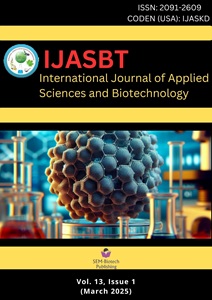Impact of Phosphate on Mat Formation, Stress Biomarkers, Antioxidants, Osmoprotectants, and Intracellular Ionic Composition in Tolypothrix sp. KJE1
DOI:
https://doi.org/10.3126/ijasbt.v13i1.74252Keywords:
Phosphate, Sucrose, Malondialdehyde, Hydrogen peroxide, Superoxide dismutaseAbstract
Increase phosphate availability enhances oxidative stress management and metabolic efficiency in Tolypothrix sp. KJE1, promoting cellular stability and growth. Under 100 mM phosphate, the organism exhibits reduced levels of H₂O₂ and malondialdehyde (MDA), indicative of improved antioxidant defenses, energy metabolism, and membrane integrity. This regulation minimizes reactive oxygen species (ROS) production and lipid peroxidation, reallocating resources from stress-associated compounds like proline and sucrose to biosynthetic pathways, thus optimizing growth. Decreased total phenol and flavonoid content under high phosphate levels further reflects reduced oxidative stress and diminished ROS production. Initially, antioxidant enzyme activities (SOD, CAT, APX, POD) peak at 25 mM phosphate to mitigate oxidative stress but decline at 100 mM due to excessive ROS accumulation and metabolic imbalances, revealing a threshold for stress tolerance. Enhance phosphate levels also modulate ion regulation, reducing Na⁺ and Ca²⁺ while increasing K⁺ concentrations to maintain osmotic balance and support metabolic processes. Enhanced carbon, nitrogen, and hydrogen assimilation under high phosphate conditions drives photosynthesis, nitrogen metabolism, and biomass production, highlighting the organism's adaptive biochemical strategies for survival in phosphate-rich environments.
Int. J. Appl. Sci. Biotechnol. Vol 13(1): 12-22.
Downloads
Downloads
Published
How to Cite
Issue
Section
License
Copyright (c) 2025 International Journal of Applied Sciences and Biotechnology

This work is licensed under a Creative Commons Attribution-NonCommercial 4.0 International License.




